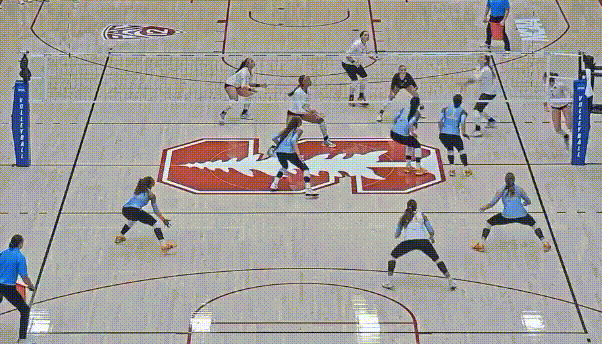Digging Profiles - Part 3
The Creator Economy
Related:
Serving Profiles
Blocking Profiles
Articles in this series:
Part 1 - Introducing The Data
Part 2 - Keepy Uppy
Part 3 - The Creator Economy
Part 4 - Conversions
The Creator Economy
Not once in the history of volleyball has a referee blown the whistle in the middle of the play and given a point for a good dig. Ultimately, digs have to lead to opportunities to transition. The relative importance of dig quality, and creating transition swings, probably changes a bit my level. I don’t have firm data on this, but coaching intuition suggests that just “getting the ball up” and getting it back over will lead to plenty of success at U12s.
As the level gets higher, ensuring that digs lead to transition attempts becomes more and more important. Let’s take a look at the teams from 2023 that were relatively the best at creating swings off digs.
Note that these weren’t necessarily the 10 best at creating swings, they were the 10 teams who relied the most on their creation % relative to the other 2 aspects of defense (Dig% and Transition Kill%). What I’m trying to study here is, “what’s the most important part of the Dig - Create - Convert chain?”
Winning And Losing
There’s a correlation between creating swings and Winning. In this sample, the correlation between Digs Created and Win% was 0.35, which is a moderate correlation. For example, the correlation between Ace:Error Ratio was 0.33.
Let’s look at the other correlations I pulled that specifically relate to defense/transition:
0.48 - Dig%
0.52 - Create%
0.50 - Convert%
0.35 - Digs Created%
0.26 - Creates Converted%
The 3 that I’m looking at the most are Dig%, DigsCreated, and CreatesConverted. The table above is related to DigsCreated, not just Create %.
(This is because Create%, as Volleymetrics calculates it, contains Dig% as part of its formula, and so does Convert%, so you’re sort of double-counting. By using the derived formulas, we avoid double-counting and untangle some of the individual elements of defense/transition a bit more.)
This was a mild surprise to me. I thought that DigsCreated and CreatesConverted (more on that in the next article) might be as high or higher than pure Dig %. But creating swings is still an important part of defense, so let’s take a look at a couple things that teams who are good in this aspect do well.
Don’t Be Afraid To Set!
The new rule-set has been talked about, so teams should be even less afraid of getting called on a bad contact now. Stephen F Austin has not been a team on my radar, but they had a great conference season and seeing them on this list made me go watch a little.
I loved this play. Quick dig and the right-side blocker throws up a clean set. The outside gets a recycle and then the setter dumps it for a kill in trans. Sweet play all-around.
Defend The Defender
I wasn’t surprised to see Tennessee on this list; they have one of the best young setters in the country in Caroline Kerr. Here’s a play that I loved and at the biggest moment: down 13-14 trying to force extra points in the 5th-set against Texas.
This is such a subtle play but it’s one that a lot of setters don’t do well. Notice how she doesn’t break to the net. Her eyes and head snap around to her defender and she reads the dig before moving. This is a relatively low/fast dig and a lot of setters break toward the net or start moving before they see the dig. On a ball like this, a lot of setters have to bumpset it or they are in a less-balanced position to handset. She has this real simple “defend the defender” posture, aware that the ball could go anywhere. Then, she makes a simple move and puts up a great set in transition.
Come Down With Your Eyes Up
UMBC is another smaller school on the rise. I’ve had the chance to listen to plenty of Kasey Crider on Coach Your Brains Out and I know he’s doing some innovative things at practice. When I watched UMBC, I wasn’t surprised to see some quick thinking and creative solutions to the chaos of transition.
I like here the right-side attacker coming down with her eyes up. She’s transitioning, but she’s also ready to stop that transition and make a good volleyball play. Something I stress at coaching clinics is good teams don’t wait for the setter to call help. You just can’t possibly have a communication loop that slow on a play like this. The right-side player just has to see and react. Here she makes a great choice to set the ball and gets her team a swing in transition.
Next up in the series, we’ll look at teams that excel at finishing the final link in the Dig - Create - Convert chain, before we move on to blocking in October.




